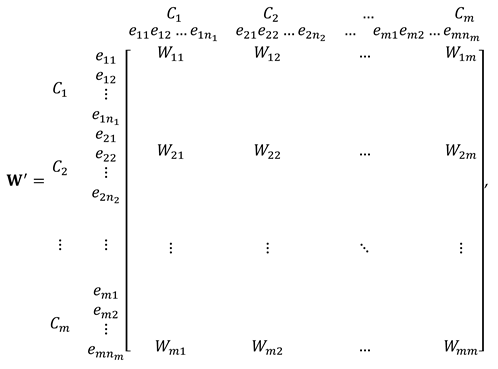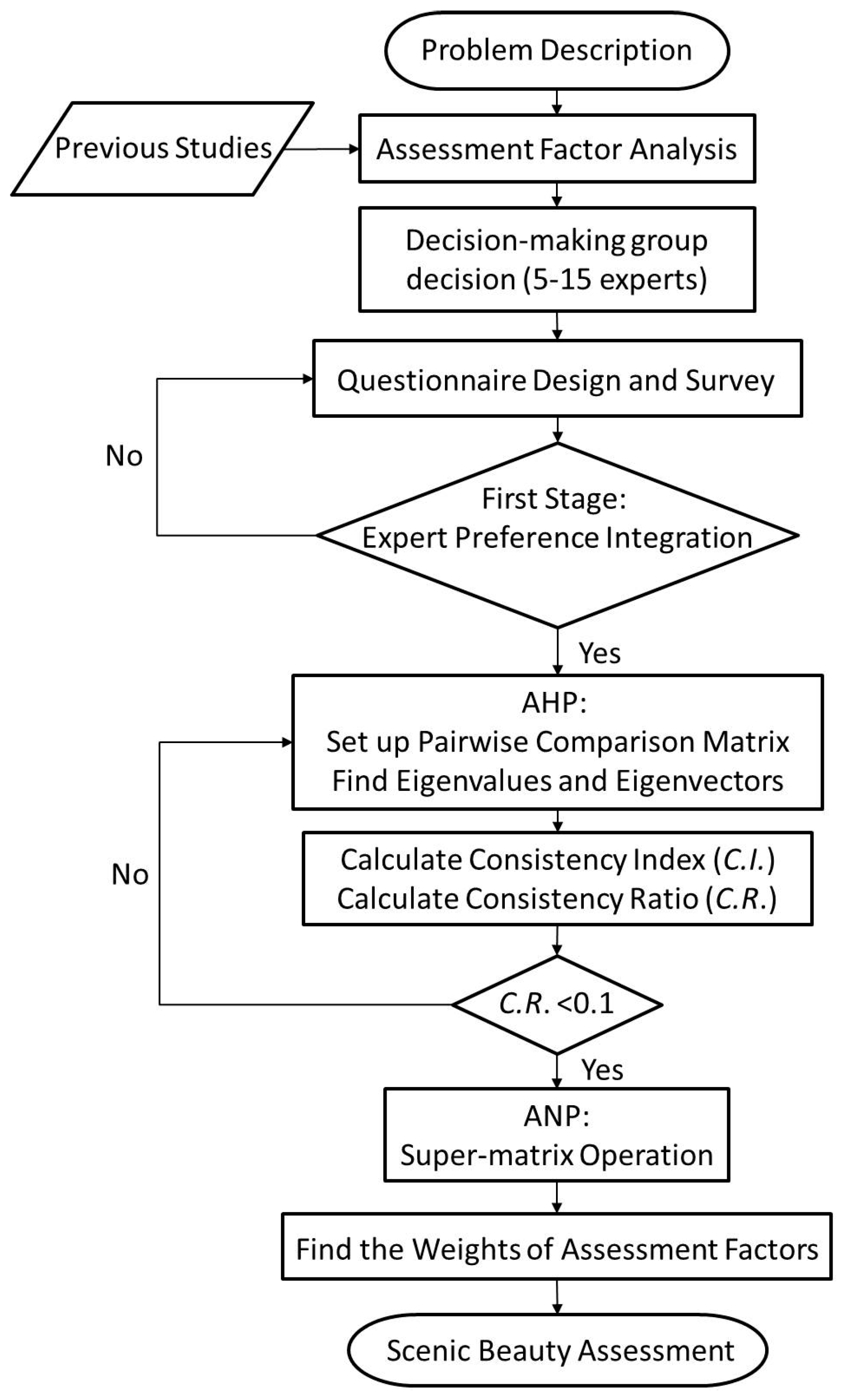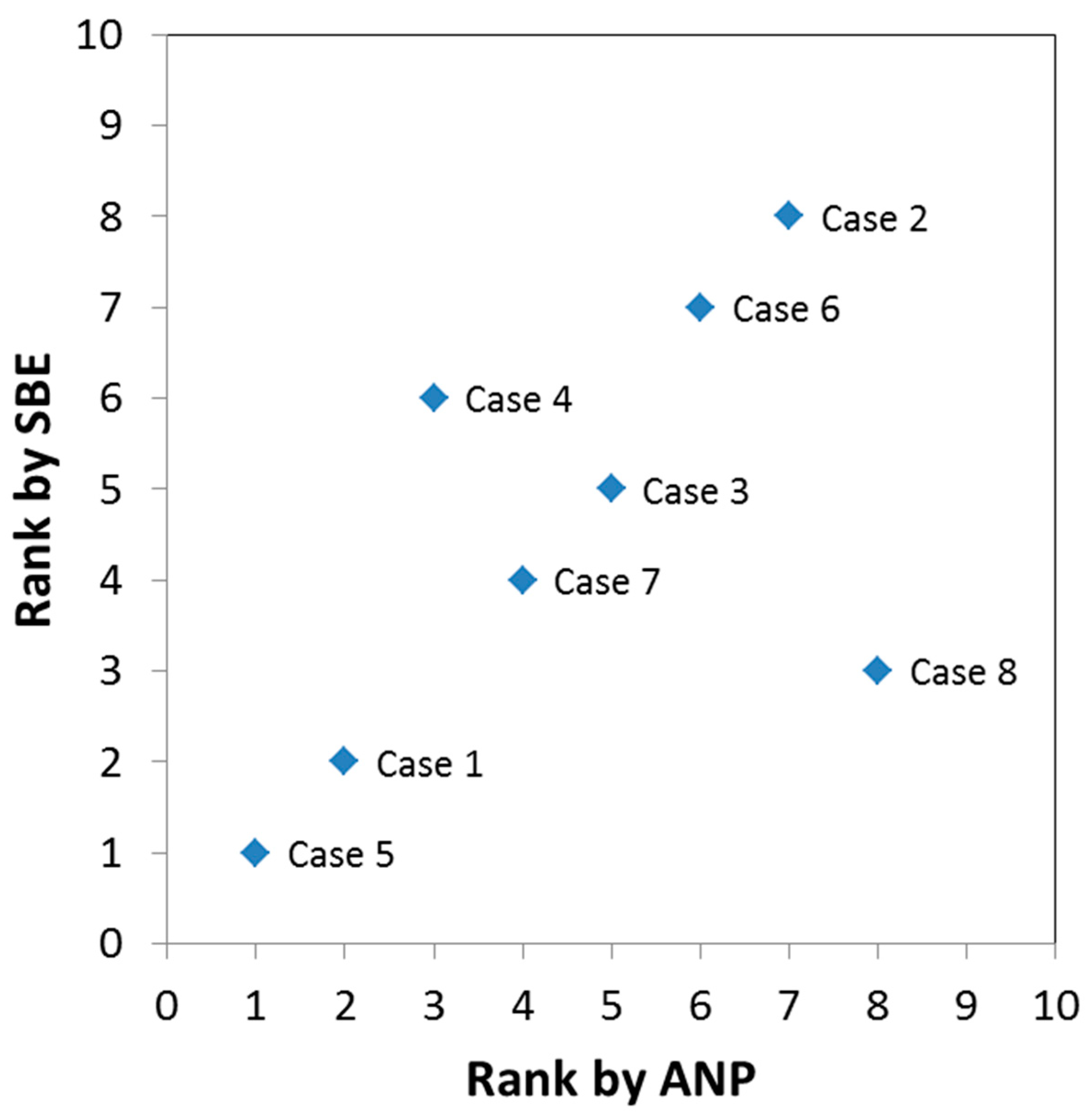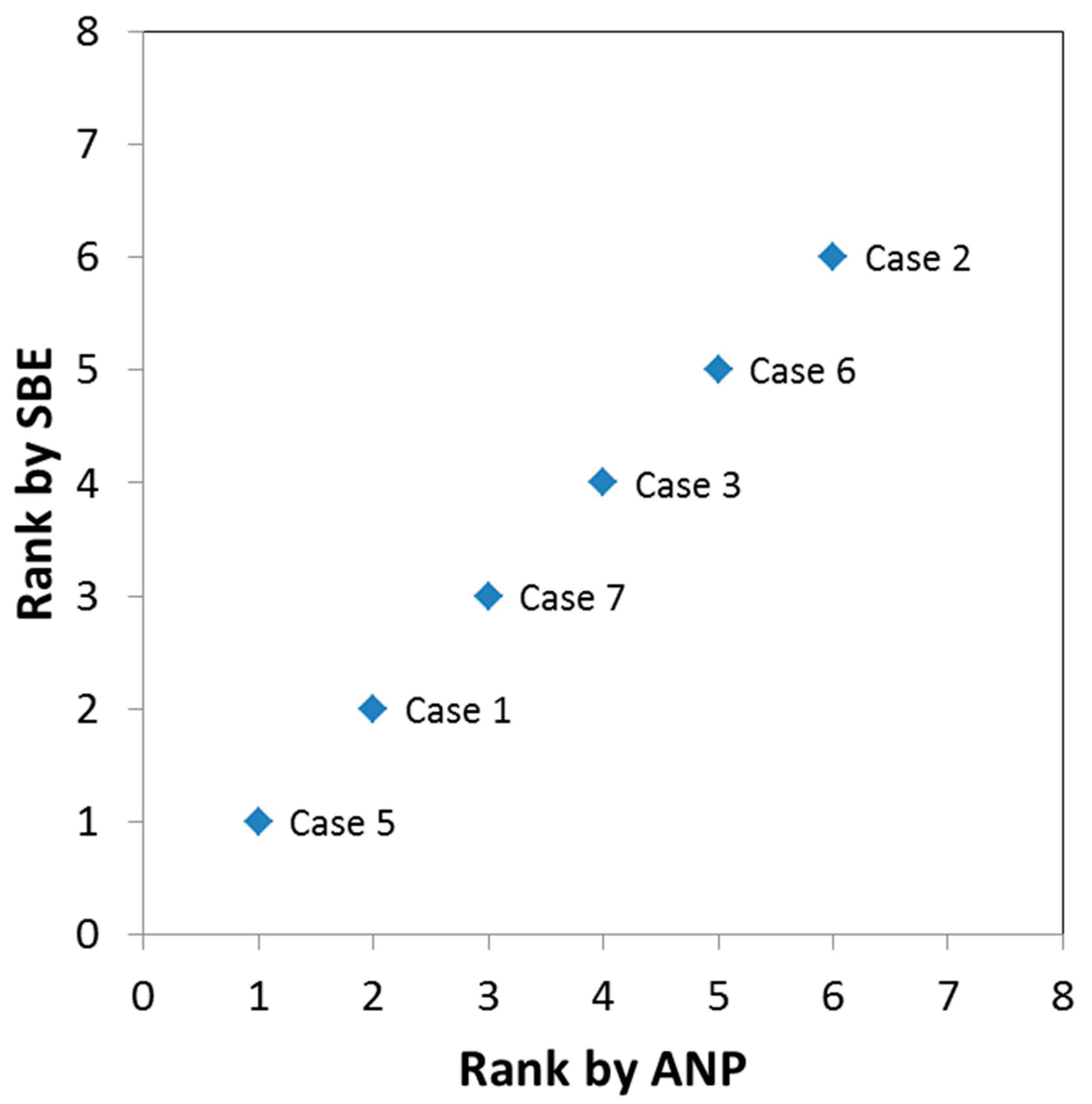Landscape Assessment for Stream Regulation Works in a Watershed Using the Analytic Network Process (ANP)
Abstract
:1. Introduction
2. Material and Methods
2.1. Design of the Expert Questionnaire
2.2. Analytic Hierarchy Process
2.3. Analytic Network Process

3. Results and Discussions
3.1. Expert Questionnaire Survey Results
3.2. Evaluation of Scenic Beauty for Watershed Stream Regulation Works
4. Conclusions
Funding
Acknowledgments
Conflicts of Interest
References
- Wu, H.L.; Feng, Z.Y. Ecological engineering methods for soil and water conservation in Taiwan. Ecol. Eng. 2006, 28, 333–344. [Google Scholar] [CrossRef]
- Jaal, Z.; Abdullah, J. User’s preferences of highway landscapes in Malaysia: A review and analysis of the literature. Procedia-Soc. Behav. Sci. 2012, 36, 265–272. [Google Scholar] [CrossRef]
- Aizawa, M. The texture of falling water, landscape, and culture of Japan. Nagare Jpn. Soc. Fluid Mech. 2004, 23, 69–78. (in Japanese). [Google Scholar]
- Newton, B.; Pringle, C.; Bjorkland, R. Stream Visual Assessment Protocol; National Water and Climate Center: Washington, DC, USA, 1998.
- FISRWG. Stream Corridor Restoration: Principles, and Practices; Federal Interagency Stream Restoration Working Group: Washington, DC, USA, 2001.
- Chen, S.Y.; Lin, J.Y. Developing a simplified river landscape assessment model: Examples from the Chungkang and Touchien Rivers, Taiwan. Environ. Monit. Assess. 2007, 127, 489–502. [Google Scholar] [CrossRef] [PubMed]
- Han, K.T. A proposed landscape assessment framework: A connection of theories and practical techniques. J. Arch. Plan. Res. 1999, 16, 313–327. [Google Scholar]
- Pfluger, Y.; Rackham, A.; Larned, S. The aesthetic value of river flows: An assessment of flow preferences for large and small rivers. Landsc. Urban Plan. 2010, 95, 68–78. [Google Scholar] [CrossRef]
- Taylor, J.G.; Zube, E.H.; Sell, J.L. Landscape assessment and perception research methods. In Methods in Environmental and Behavioral Research; Nostrand Reinhold: New York, NY, USA, 1987; pp. 361–393. [Google Scholar]
- Zube, E.H.; Sell, J.L.; Taylor, J.G. Landscape perception: Research, application and theory. Landsc. Plan. 1982, 9, 1–33. [Google Scholar] [CrossRef]
- Ananda, J.; Herath, G. The use of analytic hierarchy process to incorporate stakeholder preferences into regional forest planning. For. Policy Econ. 2003, 5, 13–26. [Google Scholar] [CrossRef]
- Chen, L.; Ng, E.; Huang, S.C.; Fang, W.T. A self-evaluation system of quality planning for tourist attractions in Taiwan: An integrated AHP-Delphi approach from career professionals. Sustainability 2017, 9, 1751. [Google Scholar] [CrossRef]
- Park, S.; Jeon, S.; Choi, C. Mapping urban growth probability in South Korea: Comparison of frequency ratio, analytic hierarchy process, and logistic regression models and use of the environmental conservation value assessment. Landsc. Ecol. Eng. 2012, 8, 17–31. [Google Scholar] [CrossRef]
- Silvennoinen, H.; Alho, J.; Kolehmainen, O.; Pukkala, T. Prediction models of landscape preferences at the forest stand level. Landsc. Urban Plan. 2001, 56, 11–20. [Google Scholar] [CrossRef]
- Wang, P.C.; Yu, C.Y. Aesthetic experience as an essential factor to trigger positive environmental consciousness. Sustainability 2018, 10, 1098. [Google Scholar] [CrossRef]
- Chen, S.C.; Lin, H.C. Visual aesthetic design principles of check dams. J. Chin. Soil Water Conserv. 2010, 41, 34–49. (In Chinese) [Google Scholar]
- Lee, S.H.; Yang, W.L. A comparison study of bioengineering streambank types. J. Archit. 2011, 78, 61–81. (In Chinese) [Google Scholar]
- Meixler, M.S.; Bain, M.B. Landscape scale assessment of stream channel and riparian habitat restoration needs. Landsc. Ecol. Eng. 2010, 6, 235–245. [Google Scholar] [CrossRef]
- Daniel, T.C.; Boster, R.S. Measuring Landscape Esthetics: The Scenic Beauty Estimation Method; Rocky Mountain Forest and Range Experiment Station: Fort Collins, CO, USA, 1976.
- Lin, H.C.; Peng, S.H.; Chen, S.C. Scenic beauty estimation of soil and water conservation engineering constructions on the slopeland. J. Soil Water Conserv. 2013, 45, 831–846. (In Chinese) [Google Scholar]
- Peng, S.H.; Han, K.T. Assessment of aesthetic quality on soil and water conservation engineering using the scenic beauty estimation method. Water 2018, 10, 407. [Google Scholar] [CrossRef]
- Saaty, T. Decisions with the Analytic Network Process (ANP); University of Pittsburgh (USA), ISAHP: Pittsburgh, PA, USA, 1996. [Google Scholar]
- Saaty, T.L. How to make a decision: The analytic hierarchy process. Eur. J. Oper. Res. 1990, 48, 9–26. [Google Scholar] [CrossRef]
- Saaty, T.L. Decision making with the analytic hierarchy process. Int. J. Serv. Sci. 2008, 1, 83–98. [Google Scholar] [CrossRef]
- Aceves, M.C.; Fuamba, M. Methodology for selecting best management practices integrating multiple stakeholders and criteria. Part 1: Methodology. Water 2016, 8, 55. [Google Scholar] [CrossRef]
- Peng, S.H.; Tang, C. Blending the analytic hierarchy process and fuzzy logical systems in scenic beauty assessment of check dams in streams. Water 2015, 7, 6983–6998. [Google Scholar] [CrossRef]
- Gumusay, M.U.; Koseoglu, G.; Bakirman, T. An assessment of site suitability for Marina construction in Istanbul, Turkey, using GIS and AHP multicriteria decision analysis. Environ. Monit. Assess. 2016, 188, 677. [Google Scholar] [CrossRef] [PubMed]
- Shapira, A.; Simcha, M. AHP-based weighting of factors affecting safety on construction sites with tower cranes. J. Constr. Eng. Manag. 2009, 135, 307–318. [Google Scholar] [CrossRef]
- Saaty, T.L.; De Paola, P. Rethinking design and urban planning for the cities of the future. Buildings 2017, 7, 76. [Google Scholar] [CrossRef]
- Bottero, M.; Comino, E.; Riggio, V. Application of the analytic hierarchy process and the analytic network process for the assessment of different wastewater treatment systems. Environ. Model. Softw. 2011, 26, 1211–1224. [Google Scholar] [CrossRef]
- Partovi, F.Y. An analytic model for locating facilities strategically. Omega 2006, 34, 41–55. [Google Scholar] [CrossRef]
- Malmir, M.; Zarkesh, M.M.K.; Monavari, S.M.; Jozi, S.A.; Sharifi, E. Analysis of land suitability for urban development in Ahwaz County in southwestern Iran using fuzzy logic and analytic network process (ANP). Environ. Monit. Assess. 2016, 188, 447. [Google Scholar] [CrossRef] [PubMed]
- Chen, L.Y. The Assessment of Typhoon and Flood Vulnerabilities in Ta-Chia River Basin: The Application of Analytic Network Process; National Taipei University: Taipei, Taiwan, 2009. (In Chinese) [Google Scholar]
- Brown, T.C.; Daniel, T.C. Scaling of Ratings: Concepts and Methods; USDA Forest Service, Rocky Mountain Forest and Range Experiment Station: Fort Collins, CO, USA, 1990; Volume 293.
- Brown, T.C.; Daniel, T.C.; Schroeder, H.W.; Brink, G.E. Analysis of Ratings: A Guide to RMRATE; US Department of Agriculture, Forest Service, Rocky Mountain Forest and Range Experiment Station: Fort Collins, CO, USA, 1990.
- Brown, T.C.; Daniel, T.C. Landscape aesthetics of riparian environments: Relationship of flow quantity to scenic quality along a wild and scenic river. Water Resour. Res. 1991, 27, 1787–1795. [Google Scholar] [CrossRef]




| Hierarchy I: Goal | Hierarchy II: Assessment Item | Hierarchy III: Factor |
|---|---|---|
| Scenic beauty assessment of stream regulation works in watershed | A. Texture and form | A-1 Lamination |
| A-2 Symmetry and balance | ||
| A-3 Integration with natural environment | ||
| A-4 Hydrophilic accessibility | ||
| B. Color | B-1 Hue | |
| B-2 Value | ||
| B-3 Chroma | ||
| C. Ecology | C-1 Biodiversity | |
| C-2 Availability of greening and vegetation space | ||
| C-3 Minimization of engineering structure | ||
| C-4 Reducing volume vision with vegetation |
| More Important on the Left | More Important on the Right | |||||||||
|---|---|---|---|---|---|---|---|---|---|---|
| Absolutely important | Extremely important | Quite important | Slightly important | Equally important | Slightly important | Quite important | Extremely important | Absolutely important | ||
| 9:1 | 7:1 | 5:1 | 3:1 | 1:1 | 1:3 | 1:5 | 1:7 | 1:9 | ||
| A. Texture and form | B. Color | |||||||||
| A. Texture and form | C. Ecology | |||||||||
| B. Color | C. Ecology | |||||||||
| A. Texture and form | B. Color | C. Ecology | Weight 1 | |
|---|---|---|---|---|
| A. Texture and form | 1 | 2.2998 | 0.3191 | 0.2456 |
| B. Color | 0.4348 | 1 | 0.2623 | 0.1320 |
| C. Ecology | 3.1339 | 3.8123 | 1 | 0.6224 |
| A-1. Lamination | A-2. Symmetry and Balance | A-3. Integration with Natural Environment | A-4. Hydrophilic Accessibility | Weight 1 | |
|---|---|---|---|---|---|
| A-1. Lamination | 1 | 1.0909 | 0.3503 | 0.6984 | 0.1470 |
| A-2. Symmetry and balance | 0.9167 | 1 | 0.2130 | 0.8851 | 0.1293 |
| A-3. Integration with natural environment | 2.8549 | 4.6938 | 1 | 4.4410 | 0.5655 |
| A-4. Hydrophilic accessibility | 1.4319 | 1.1298 | 0.2252 | 1 | 0.1582 |
| B-1. Hue | B-2. Value | B-3. Chroma | Weight 1 | |
|---|---|---|---|---|
| B-1. Hue | 1 | 1.7395 | 1.6901 | 0.4478 |
| B-2. Value | 0.5749 | 1 | 2.7850 | 0.3657 |
| B-3. Chroma | 0.5917 | 0.3591 | 1 | 0.1865 |
| C-1. Biodiversity | C-2. Availability of Greening and Vegetation Space | C-3. Engineering Structure Minimal Design | C-4. Reducing Volume Vision with Vegetation | Weight 1 | |
|---|---|---|---|---|---|
| C-1. Biodiversity | 1 | 4.9413 | 3.5870 | 4.4932 | 0.5826 |
| C-2. Availability of greening and vegetation space | 0.2024 | 1 | 0.7435 | 1.2915 | 0.1286 |
| C-3. Engineering structure minimization design | 0.2788 | 1.3450 | 1 | 2.1729 | 0.1851 |
| C-4. Reducing volume vision with vegetation | 0.2226 | 0.7743 | 0.4602 | 1 | 0.1038 |
| Item | Assessment Factor | AHP Weight | ANP Weight |
|---|---|---|---|
| A. Texture and form | A-1 Lamination | 3.61% | 2.64% |
| A-2 Symmetry and balance | 3.17% | 5.13% | |
| A-3 Integration with natural environment | 13.89% | 30.18% | |
| A-4 Hydrophilic accessibility | 3.89% | 2.20% | |
| B. Color | B-1 Hue | 5.91% | 1.54% |
| B-2 Value | 4.83% | 2.39% | |
| B-3 Chroma | 2.46% | 1.29% | |
| C. Ecology | C-1 Biodiversity | 36.26% | 29.56% |
| C-2 Availability of greening and vegetation space | 8.00% | 6.28% | |
| C-3 Minimization of engineering structure | 11.52% | 8.79% | |
| C-4 Reducing volume vision with vegetation | 6.46% | 10.01% |
| Sub-Item | Particular | Evaluation Criteria |
|---|---|---|
| A. Texture and form | A-1. Lamination: Texture characteristics on engineering structure | Natural materials close to local landscape are selected for structure (3 points) Textures similar to natural materials are used for structure (2 points) Material of artificial structure is inconsistent with environment (1 point) |
| A-2. Symmetry and balance: Same forms on both sides of axis | Same visual shapes on both sides of axis (3 points) Different shapes on both sides of axis, but conforming to the harmony of modeling force field (2 points) Different shapes on both sides of axis (1 point) | |
| A-3. Integration with natural environment: Structure contour corresponding to the graceful skyline and the visual effect of high integration with environment being able to reduce the monotone of symmetric structure | Very similar outline for structure and skyline (3 points) Similar outline for structure and skyline (2 points) Little similarity between outlines of structure and skyline (1 point) | |
| A-4. Hydrophilic accessibility: Available hydrophilic space in the engineering design | Traffic flow reaches water and hydrophilic facilities are available or landscape is planned to provide space on both banks (3 points) Traffic flow does not reach water, but hydrophilic facilities are available or landscape is planned to provide space on both banks; or, traffic flow reaches water, but hydrophilic facilities are not available or landscape is not planned on both banks (2 points) Traffic flow does not reach water, and hydrophilic facilities are not available or landscape is not planned for the space on both banks (1 point) | |
| B. Color | B-1. Hue: Blue, green, yellow, red, and purple as the representatives | Yellowish brown, green (3 points) Red and yellow (2 points) Other colors (1 point) |
| B-2. Value: 0–10 (black is 0, white is 10, standard gray is 5) | Forest value 7.5–8.5 (3 points) Grassland value 7–8 (2 points) Sand land value 7.5–9 (1 point) | |
| B-3. Chroma: 0–20 (higher scores show more vividness) | Forest chroma 2–4 (3 points) Grassland chroma 1–4 (2 points) Sand land chroma 1–4 (1 point) | |
| C. Ecology | C-1. Biodiversity 1: Also called species diversity index, the degree of life change | More than three plant species (3 points) Two plant species (2 points) Only one plant species or null (1 point) |
| C-2. Availability of greening and vegetation space: To improve the patterns of cement or concrete in the environment to increase comfort | With broad space and using plants for environment greening (3 points) No broad space, but harmonious with original ecology (2 points) No broad space and over-artificial (1 point) | |
| C-3. Engineering structure minimization: Revetment, check dam, submerged dam, and groundsill works for stream disaster control could effectively reduce the impact of construction on environment and reduce damage to natural ecology | Green planting more than two-thirds of concrete area (3 points) Green planting more than one-third of concrete area but less than two-thirds (2 points) Mostly artificial and little natural ecology (1 point) | |
| C-4. Reducing volume vision with vegetation: Proportion of vegetation and structure | Flourishing planting to cover most structures (3 points) Planting to cover some structure (2 points) Little planting to cover structure (1 point) |
| Sub-Item | Particular | Weight | Case 1 | Case 2 | Case 3 | Case 4 | Case 5 | Case 6 | Case 7 | Case 8 |
|---|---|---|---|---|---|---|---|---|---|---|
 |  |  |  |  |  |  |  | |||
| A. Texture and form | A-1 | 2.64% | 3 | 1 | 2 | 1 | 3 | 2 | 2 | 2 |
| A-2 | 5.13% | 2 | 1 | 2 | 2 | 2 | 1 | 2 | 3 | |
| A-3 | 30.18% | 2 | 1 | 1 | 2 | 3 | 1 | 1 | 1 | |
| A-4 | 2.20% | 3 | 1 | 2 | 2 | 3 | 1 | 2 | 2 | |
| B. Color | B-1 | 1.54% | 3 | 3 | 3 | 1 | 3 | 1 | 3 | 1 |
| B-2 | 2.39% | 1 | 1 | 3 | 1 | 2 | 1 | 3 | 1 | |
| B-3 | 1.29% | 1 | 1 | 3 | 1 | 2 | 1 | 3 | 1 | |
| C. Ecology | C-1 | 29.56% | 3 | 1 | 3 | 3 | 3 | 2 | 3 | 1 |
| C-2 | 6.28% | 3 | 2 | 2 | 3 | 3 | 2 | 2 | 1 | |
| C-3 | 8.79% | 3 | 3 | 3 | 3 | 3 | 2 | 2 | 2 | |
| C-4 | 10.01% | 1 | 3 | 1 | 1 | 1 | 1 | 2 | 1 | |
| Evaluation result 1 | 76.14 | 46.75 | 65.15 | 73.89 | 87.31 | 47.87 | 65.56 | 39.94 | ||
| Ranked by this study | 2 | 7 | 5 | 3 | 1 | 6 | 4 | 8 | ||
| SBE | 127.36 | −155.48 | 14.55 | −73.81 | 164.71 | −125.89 | 42.46 | 66 | ||
| Ranked by SBE | 2 | 8 | 5 | 6 | 1 | 7 | 4 | 3 | ||
© 2019 by the author. Licensee MDPI, Basel, Switzerland. This article is an open access article distributed under the terms and conditions of the Creative Commons Attribution (CC BY) license (http://creativecommons.org/licenses/by/4.0/).
Share and Cite
Peng, S.-H. Landscape Assessment for Stream Regulation Works in a Watershed Using the Analytic Network Process (ANP). Sustainability 2019, 11, 1540. https://doi.org/10.3390/su11061540
Peng S-H. Landscape Assessment for Stream Regulation Works in a Watershed Using the Analytic Network Process (ANP). Sustainability. 2019; 11(6):1540. https://doi.org/10.3390/su11061540
Chicago/Turabian StylePeng, Szu-Hsien. 2019. "Landscape Assessment for Stream Regulation Works in a Watershed Using the Analytic Network Process (ANP)" Sustainability 11, no. 6: 1540. https://doi.org/10.3390/su11061540
APA StylePeng, S.-H. (2019). Landscape Assessment for Stream Regulation Works in a Watershed Using the Analytic Network Process (ANP). Sustainability, 11(6), 1540. https://doi.org/10.3390/su11061540





